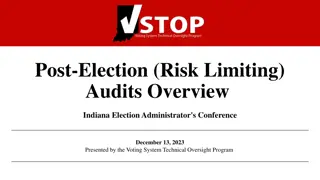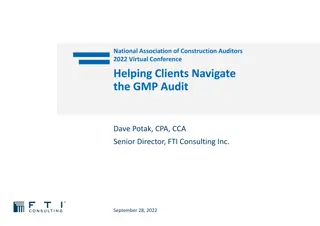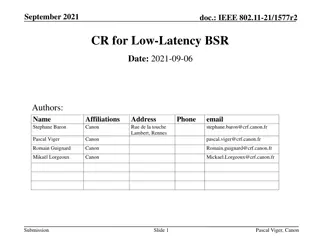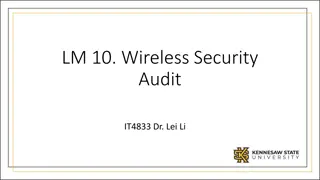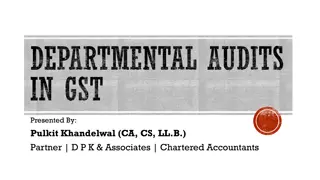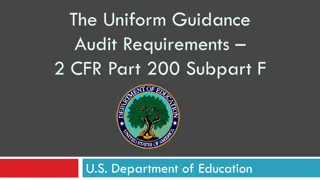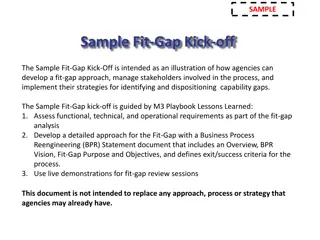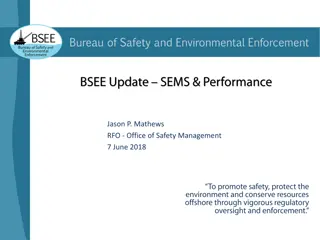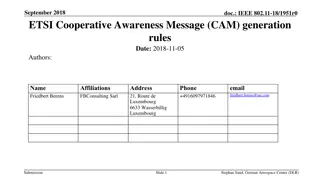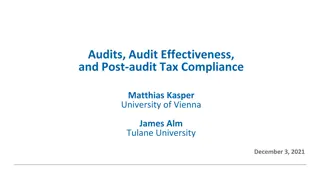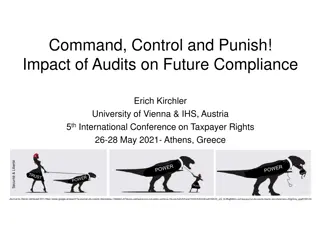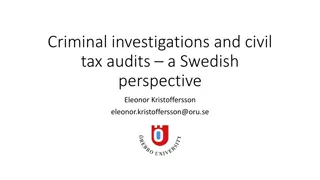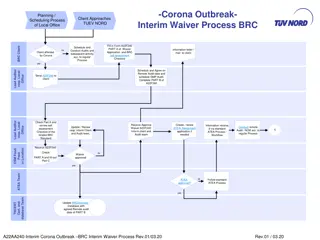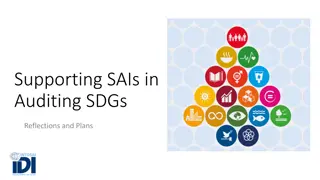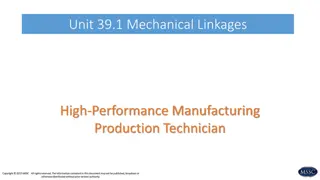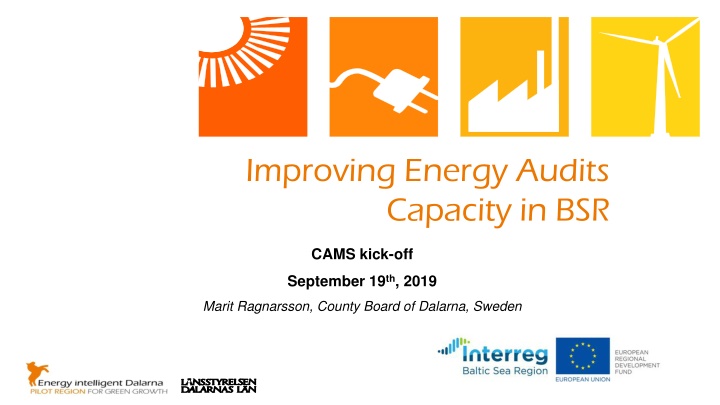
Improving Energy Audits Capacity in BSR CAMS Kick-off September 19th, 2019
From the kick-off event featuring Marit Ragnarsson, County Board of Dalarna, Sweden, learn about regional energy strategies, climate goals, financial tools for energy-efficient buildings, and measures to unlock investments in energy efficiency. Explore methodologies for energy audits, multi-service contracts, and green leasing contracts to lower risks and increase profitability.
Download Presentation

Please find below an Image/Link to download the presentation.
The content on the website is provided AS IS for your information and personal use only. It may not be sold, licensed, or shared on other websites without obtaining consent from the author. If you encounter any issues during the download, it is possible that the publisher has removed the file from their server.
You are allowed to download the files provided on this website for personal or commercial use, subject to the condition that they are used lawfully. All files are the property of their respective owners.
The content on the website is provided AS IS for your information and personal use only. It may not be sold, licensed, or shared on other websites without obtaining consent from the author.
E N D
Presentation Transcript
Improving Energy Audits Capacity in BSR CAMS kick-off September 19th, 2019 Marit Ragnarsson, County Board of Dalarna, Sweden
150px-SverigesL%C3%A4n2007Dalarna County Board of Dalarna: - Regional state authority responsible for managing and coordinating regional energy and climate work - Lead of national network for regional coordinators
A regional A regional organization for organization for cooperation cooperation Regional energy and climate strategy RENEWABLE BUILDINGS INNOVATION AND GROWTH Road maps for each sector Energy Intelligent Energy Intelligent Dalarna Dalarna CONSUMPTION INDUSTRY/ SME AGRICULTURE AND FORESTRY TRANSPORTS
Swedish Swedish climate - - The The world world s s most climate and most ambitious and energy energy goals ambitious goals goals goals ?! ?! By 2030: 50 % Energy efficiency (compared to 2005) By 2030: 63 % cut in Greenhouse Gas Emissions (compared to 1990) By 2040: 100 % renewables By 2045: Zero net Greenhouse Gas Emissions (at least 85 % of the cut in Sweden)
EFFECT4buildings Overcoming financial obstacles for implementation of energy efficient meausures in buildings Development of financial tools Capacity building among target group Lower the risks to implement measures Unlock investments in energy efficiency
Financial tools Multi service contracts Financial calculation tools Investment funding Energy Performance Technology solution providers Contracting Ability to convince decision Bundling makers Green Leasing Contracts Methodology for energy audits (to evaluate profitabiltiy potential) Prosumerism
To To reach reach the potential the potential Every entety needs to know what energy efficiency measures they can implement and get support to implement them. Number SME Using >300 MWh annually 70 700 1050 2 600 530 60 320 250 700 350 150 200 EXAMPLE FROM DALARNA Primary food producers Transport companies, contractors Real estate companies and condominiums Others, - Manufacturing and coating industry - Service and repairs - Building, installations, craftsmen - Trade and vehicle service - Sales and shops - Hotels and restaurants - Care, education, leisure - Others ? 680 100 500
Experiences Experiences and and recommendations recommendations Increase the pace with energy auditing * Structure it by business categories * Reduce the administrative work to apply for funding for energy audits and adjust the amount of grants according to type of business. Implement a pilot with more cost-efficient energy audits based on data base* Continue to give aid for technical assistance (TA/environmental studies). Increase the quality requirements for energy audits* Introduce a standard for what kind of data that should be included in energy audits to make it possible to generate key figures* Establish national/European data base to collect high quality data from energy audits, to generate new knowledge and enable benchmarking*
Energy auditing Energy balance Energy measures Summary Summary of all energy input Mapping of all energy use Pedagogical presentation of how the energy use is allocated Mapping all possible measures Profitability calculations Presented in an understandable way Summary for decision makers
WP WP 2.1 Identification of development needs in energy auditing 2.1 Identification of development needs in energy auditing 2.1.1 Mapping of current situation and development needs (Dec/Jan) - How are energy audits carried out in partner countries? Standards, qualities, certified energy auditors 2.1.2 Transnational Energy Audit Day, in Sweden, (December) - Results are presented and discussed. Exchange of experience. - Identify development needs - Presentation of Swedish pilot on energy auditing with a data base - A detailed plan for facilitating a common BSR energy auditing methodology and platform. Output 2.1 (January) A report that describes the current situation in partner countries, conclusions from transnational comparison and documentation of development needs A detailed plan for method development
WP WP 2.2 Elaborating the methodology, benchmarking and cross 2.2 Elaborating the methodology, benchmarking and cross- - Baltic capitalization Baltic capitalization 2.2.1 Procurement of platform provider (November) - Partners map if there is suppliers who already have existing platforms that fully or partly correspond to the project's needs. - Open announced request for tenders for training and system development. 2.2.2 Platform design (January April) -including translations 2.2.3 National Energy Auditing Days in each partner country (Feb-May) - With energy auditors and provider of platform - Presentation of platform method - Plan for energy audit pilots 2.2.4 Energy audit pilots based on the platform method (Apr Nov) - Consultant acts as supervisor during the implementation - Results from the energy audits are presented to each customer
2.2.5 Additional adaptations of the platform and methodology (Apr 2021) - Based on the experiences from the energy audits carried out - Transnational Energy Audit Network Day in Riga for know-how exchange Output 2.1 (April 2021) Database of energy audits Dissemination of results
WP WP 2.3 Policy recommendations on energy auditing 2.3 Policy recommendations on energy auditing 2.3.1 Formulate policy recommendations for national/BSR level (-Apr 2021) - Based on partner positions 2.3.2 Presentation of policy recommendations for national/BSR level (June 2021) - Mapping relevant policy makers - Present draft policy recommendations for discussion at Riga networking meeting. - Final policy recommendations
WP2 WP2 Next Next step step Together: - Decide dates for Transnational Audit Day in Sweden - Agree on request for tender Individual task - Finding out how energy audits are carried out today, including standards, qualities etc - Mapping certified energy auditors - Decide participation in Transnational Audit Day
Energy auditing platform methodology Energy measures Implementatio n Energy balance Finding probable measures through database Standardized way to list measures Tools for financial calculations Measures added to database Provide tools for implementation Benchmarking Follow up Standardized way to collect and present data Results added to database Extracting and using data for R&D, new projects, technology development, solution providers etc
What buildings to target in the pilots? Each partner do 5 audits of the same kind of buildings (but not the same for all - More cost effective (one expert doing several of the same kind) - Higher quality with more measures - Benchmarking possible for each partner Added value: If adding data from more/other energy audits, benchmarking can be possible between partners.

